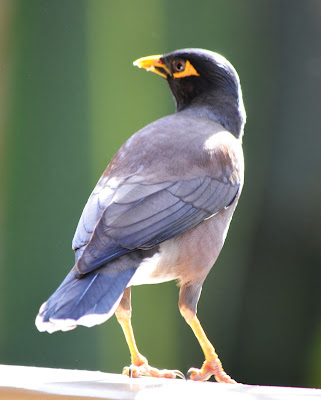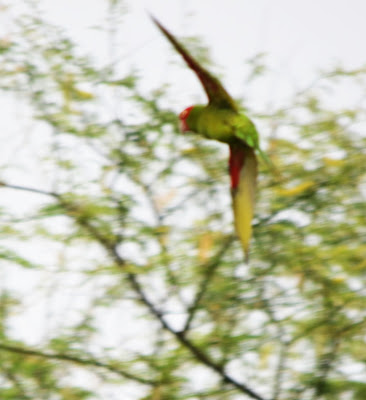Well spring is officially here judging be the date, maybe the weather has not quite caught up to the season but the days are getting longer.
Here are a few pictures of Myna (Mynah) birds, they seem to be perpetually in a bad mood. I am taking this opportunity to put a few words in their "becks":
"Mynah or myna birds are species in the family Sturnidae, which also includes many species of starlings. The distinction between starlings and mynahs is not always clear, and these common names are sometimes used interchangeably. However, as considered here, the mynahs are tropical, Asian species, the most prominent of which are in the genus Acridotheres and Gracula.
The word mynah is derived from the Hindu word maina, itself derived from the Sanskrit word madana, both of which are names for the hill mynah.
Species of mynahs occur in forests, shrubby woodlands, and in urban and suburban habitats. Mynahs are medium-sized, stocky, robust birds, with a stout beak, strong legs, and a short tail. Their songs are innovative, raucous chatters made up of whistles, squeaks, and diverse, imitated sounds. Mynahs feed on a wide range of invertebrates and fruits. They nest in cavities in trees, and both sexes cooperate in feeding and raising the young birds."
The red-masked parakeet is a fairly large green parakeet originally from Ecuador and Peru where the population is in decline due to loss of habitat. Feral populations exist in many parts of United States including Hawaii.
"They have a bright red face, forehead and crown; orbital ring is white; iris is orange. They are slightly yellow below; shoulder, edge of wing, lower thigh and outermost underwing coverts at bend in wing and on thighs are red. The underside of the wing and tail are olive yellow. Sexes are similar. Juveniles have green plumage until their first red feathers come in at around four months. They have a brown iris, rather than orange.
Red-masked Parakeet: Their diet includes the seeds and fruit of several different tree species and Erythrina flowers. These birds have been observed feeding on the fruits of the cultivated tropical vegetation. They travel in groups of two to twelve birds, sometimes many more at communal roosts or near prolific food supplies. They move seasonally over long distances to find crops of fruits."
These birds are really chatty but they are fun to watch ... oh and messy eaters.
Here are a few pictures of Myna (Mynah) birds, they seem to be perpetually in a bad mood. I am taking this opportunity to put a few words in their "becks":
"I don't want to sound like a grumpy old man, but nothing winds me up more than people saying, 'Chill out' to me when I'm irritated!"
Martin Freeman
"I don't argue with idiots. They will just lower me to their level, then beat me with their experience."
"I don't hate people. I just feel better when they're not around."
Charles Bukowski
"Who ate your bowl of sunshine this morning, thundercloud."
"I am so grumpy I am not even talking to myself!"
The word mynah is derived from the Hindu word maina, itself derived from the Sanskrit word madana, both of which are names for the hill mynah.
Species of mynahs occur in forests, shrubby woodlands, and in urban and suburban habitats. Mynahs are medium-sized, stocky, robust birds, with a stout beak, strong legs, and a short tail. Their songs are innovative, raucous chatters made up of whistles, squeaks, and diverse, imitated sounds. Mynahs feed on a wide range of invertebrates and fruits. They nest in cavities in trees, and both sexes cooperate in feeding and raising the young birds."
Mynah birds are talented mimics, they can be taught to speak and can copy other animal noises.
Here is a YouTube video called "Morning Talk with my Mynah "Kaleo" "
------------------------------------------------
A more cheerful looking bird and one of my favorite tropical birds is the Red-masked Parakeet, there was a flock quite close to where I stayed in Hawaii so I got a lot of pictures, I will share some of them here.
The red-masked parakeet is a fairly large green parakeet originally from Ecuador and Peru where the population is in decline due to loss of habitat. Feral populations exist in many parts of United States including Hawaii.
"They have a bright red face, forehead and crown; orbital ring is white; iris is orange. They are slightly yellow below; shoulder, edge of wing, lower thigh and outermost underwing coverts at bend in wing and on thighs are red. The underside of the wing and tail are olive yellow. Sexes are similar. Juveniles have green plumage until their first red feathers come in at around four months. They have a brown iris, rather than orange.
Red-masked Parakeet: Their diet includes the seeds and fruit of several different tree species and Erythrina flowers. These birds have been observed feeding on the fruits of the cultivated tropical vegetation. They travel in groups of two to twelve birds, sometimes many more at communal roosts or near prolific food supplies. They move seasonally over long distances to find crops of fruits."
These birds are really chatty but they are fun to watch ... oh and messy eaters.
Here is a YouTube video of their chatter:
"Eating without conversation is only stoking."
Marcelene Cox
...very entertaining to watch..........
"The only think I like better than talking about food is eating."
John Walters
No, this is my better side......
"Any fool can criticize, condemn and complain and most fools do."
Benjamin Franklin
Benjamin Franklin
...look Ma no hands........
"When a thing is funny, search it for a hidden truth."
George Bernard Shaw
George Bernard Shaw
"Learn the rules so you know how to break them properly."
Dalai Lama
Dalai Lama
"A generous heart, kind speech, and a life of service and compassion
are the things which renew humanity."
The Buddha
are the things which renew humanity."
The Buddha
"The only thing to do with good advice is to pass it on.
It is never of any use to oneself."
Oscar Wilde
It is never of any use to oneself."
Oscar Wilde
"People who think they know everything are a great annoyance to those of us who do."
Isaac Asimov
Isaac Asimov
I hope you have enjoyed this edition of birds with attititude.
--------------------------------------------------
New from my studio:
First, here is a watercolour named "Anyone Home".
Raccoons are cheeky little animals, I have heard stories about raccoons that knock on the door for handouts!
Second, and last for today, is a watercolour called "A stroll at dusk"; it is of a couple (and their dog) walking west along Spanish Banks in the winter as the sun disappears below the horizon. Oh, that is downtown Vancouver in the background.
That's all I have for you this week, happy Wednesday, with whimsy,
Gillian.





















































